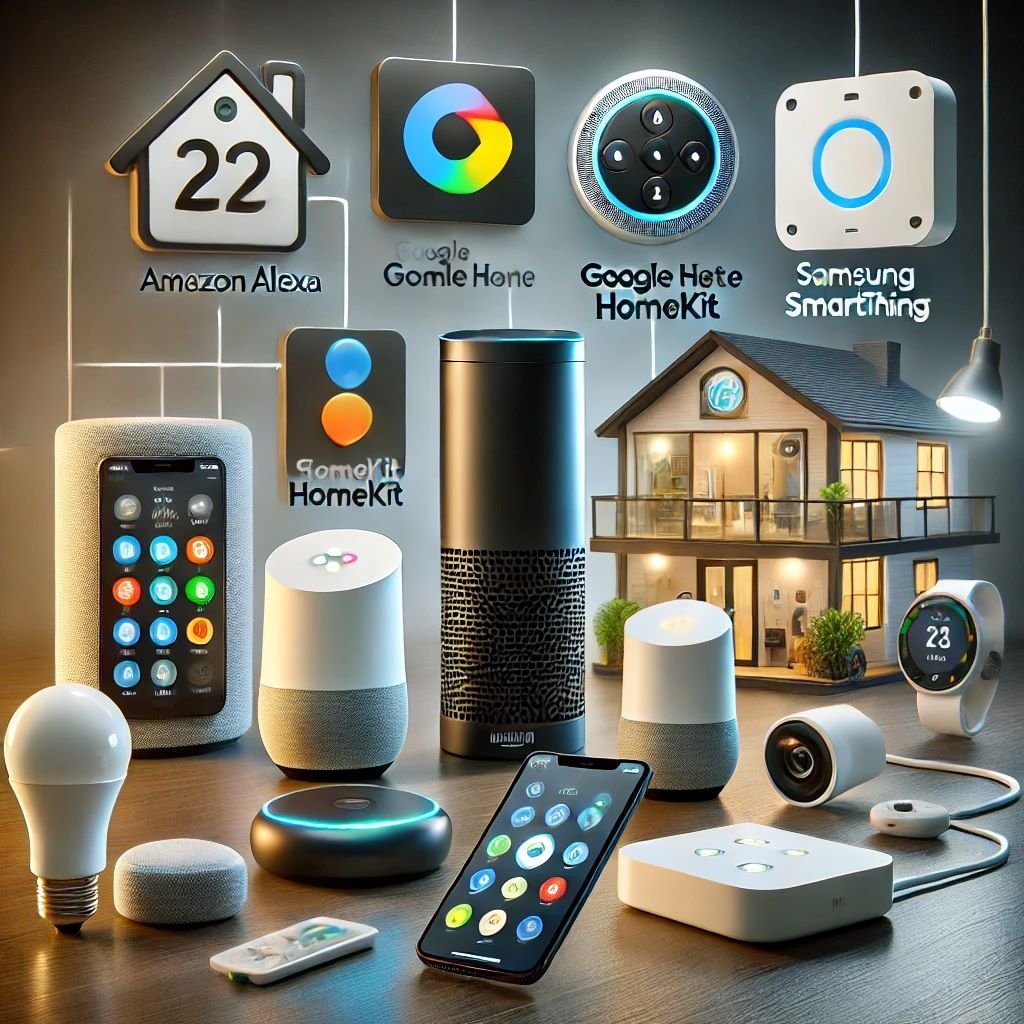Comprehensive Article on Popular Smart Home Platforms
Introduction
Smart home platforms have revolutionized the way we interact with our living spaces, offering unprecedented convenience, security, and efficiency.
Among the leading smart home ecosystems are Amazon Alexa, Google Home, Apple HomeKit, and Samsung SmartThings.
Each platform offers unique features and benefits, catering to different user preferences and technological ecosystems.
This article explores the capabilities, integrations, and distinctive advantages of these popular smart home platforms.
Amazon Alexa
Overview
Amazon Alexa is a cloud-based voice service that powers a range of Amazon Echo devices and third-party smart home gadgets.
Launched in 2014, Alexa has become one of the most popular and versatile smart home platforms, known for its extensive compatibility and user-friendly voice control.
Key Features
-
Voice Control:
- Users can control smart home devices, play music, check weather updates, set reminders, and more using voice commands.
- Example: “Alexa, turn off the living room lights.”
-
Smart Home Integration:
- Alexa supports a wide array of smart home devices, including lights, thermostats, cameras, and locks from brands like Philips Hue, Nest, and Ring.
- Example: Seamlessly integrating smart bulbs and setting up routines to automate lighting based on time or activity.
-
Skills and Routines:
- Alexa Skills are third-party apps that enhance the platform’s capabilities, offering everything from fitness coaching to news updates.
- Routines allow users to automate multiple actions with a single command.
- Example: Creating a morning routine that turns on lights, plays news briefings, and starts the coffee maker.
-
Echo Devices:
- A range of Echo devices, from the compact Echo Dot to the screen-equipped Echo Show, cater to different user needs and preferences.
- Example: Using an Echo Show in the kitchen to follow recipe videos hands-free.
Advantages
- Extensive Compatibility: Alexa works with a vast number of smart home devices, making it highly versatile.
- Customizability: Skills and routines offer extensive customization options for personalizing the smart home experience.
- Voice Assistant Integration: Seamless integration with Amazon’s ecosystem, including Prime services and Fire TV.
Google Home
Overview
Google Home, powered by Google Assistant, is a robust smart home platform that leverages Google’s powerful search and AI capabilities.
Launched in 2016, Google Home offers comprehensive voice control and integration with various smart home devices and services.
Key Features
-
Voice Control:
- Users can issue voice commands to control smart home devices, access information, play media, and manage daily tasks.
- Example: “Hey Google, set the thermostat to 72 degrees.”
-
Smart Home Integration:
- Google Home supports a wide range of smart home devices from manufacturers like Nest, Philips, and TP-Link.
- Example: Using Google Home to control Nest Thermostats and Nest Cameras for home automation and security.
-
Routines and Automation:
- Google Home allows users to create routines that automate multiple actions with a single voice command.
- Example: Setting up a bedtime routine that dims lights, locks doors, and plays relaxing music.
-
Google Services Integration:
- Deep integration with Google services like Calendar, Maps, and Chromecast enhances functionality and user experience.
- Example: Asking Google Home to add events to your Google Calendar or stream videos to a Chromecast-enabled TV.
Advantages
- Search Capabilities: Leveraging Google’s search engine ensures accurate and comprehensive responses to queries.
- Device Compatibility: Supports a wide range of smart home devices, offering flexibility and ease of integration.
- Google Ecosystem: Seamless integration with Google services and devices enhances convenience and functionality.
Apple HomeKit
Overview
Apple HomeKit is a smart home platform designed to provide a secure and user-friendly experience for iOS users.
Introduced in 2014, HomeKit integrates with Apple’s ecosystem, allowing users to control compatible smart home devices through the Home app and Siri.
Key Features
-
Privacy and Security:
- HomeKit places a strong emphasis on user privacy and security, ensuring that data is encrypted and controlled by the user.
- Example: Using end-to-end encryption for data exchanged between HomeKit devices.
-
Voice Control:
- Users can control smart home devices, check information, and perform tasks using Siri voice commands.
- Example: “Hey Siri, turn off the bedroom lights.”
-
Home App:
- The Home app on iOS devices offers a centralized interface for managing all HomeKit-enabled devices.
- Example: Using the Home app to set up scenes and automations that control multiple devices simultaneously.
-
Automation:
- HomeKit supports advanced automation, allowing users to create triggers based on time, location, or device status.
- Example: Setting up an automation that turns on lights when you arrive home.
-
Secure Video:
- HomeKit Secure Video offers encrypted video streaming and storage for supported security cameras.
- Example: Using HomeKit Secure Video to monitor home security cameras and store footage securely in iCloud.
Advantages
- Enhanced Security: Strong focus on privacy and security, appealing to users concerned about data protection.
- Apple Ecosystem Integration: Seamless integration with iOS devices and services, providing a cohesive user experience.
- User-Friendly Interface: The Home app offers an intuitive and easy-to-navigate interface for managing smart home devices.
Samsung SmartThings
Overview
Samsung SmartThings is a versatile and widely compatible smart home platform that supports a broad range of devices and protocols.
Launched in 2012 and acquired by Samsung in 2014, SmartThings provides comprehensive control and automation capabilities for smart homes.
Key Features
-
Hub-Based Control:
- The SmartThings Hub acts as a central controller, connecting and managing various smart home devices, including Zigbee and Z-Wave devices.
- Example: Using the SmartThings Hub to control lights, locks, and sensors from different manufacturers.
-
Device Compatibility:
- SmartThings supports a wide array of devices from brands like Samsung, Philips, and Aeotec, offering extensive compatibility.
- Example: Integrating SmartThings with Samsung smart appliances for unified control.
-
Automations and Scenes:
- Users can create automations and scenes to control multiple devices based on triggers like time, location, or device status.
- Example: Setting up a “Good Morning” scene that turns on lights, adjusts the thermostat, and starts the coffee maker.
-
SmartThings App:
- The SmartThings app provides a centralized interface for managing connected devices, creating automations, and monitoring home status.
- Example: Using the SmartThings app to receive alerts when motion is detected or a door is opened.
-
Integration with Bixby and Other Assistants:
- SmartThings integrates with Samsung’s Bixby voice assistant and supports other voice assistants like Alexa and Google Assistant.
- Example: Controlling SmartThings devices using voice commands through Bixby or Alexa.
Advantages
- Wide Device Compatibility: Supports a broad range of smart home devices and protocols, offering flexibility and scalability.
- Centralized Control: The SmartThings Hub provides unified control and management of various devices.
- Versatile Automation: Advanced automation capabilities allow for customized and complex smart home scenarios.
Each of these popular smart home platforms—Amazon Alexa, Google Home, Apple HomeKit, and Samsung SmartThings—offers unique features and advantages tailored to different user preferences and ecosystems.
Amazon Alexa stands out for its extensive compatibility and customizability, Google Home excels in search capabilities and integration with Google services, Apple HomeKit emphasizes privacy and seamless integration with iOS devices, and Samsung SmartThings provides versatile control and broad device compatibility.
By understanding the distinctive qualities of each platform, users can choose the one that best fits their needs and preferences, enhancing their smart home experience.
This comprehensive article provides an in-depth overview of the leading smart home platforms, highlighting their key features, advantages, and unique offerings.









